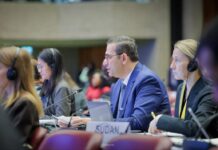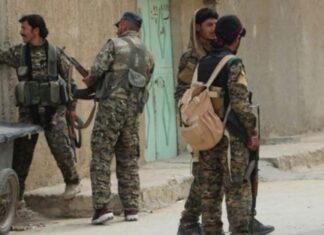
It was just after 10 a.m. on May 22 when four Syrian Civil Defense, also known as the White Helmets, volunteers arrived in the village of Karah, northeast of Hama, to inspect what they believed was unexploded ordnance near a rail line. This kind of call was not unusual—unexploded ordnance (UXO) removal is a core part of their work.
With protective gear on, three of the men exited their vehicle to investigate. Moments later, one shouted a warning—what they saw wasn’t just debris. It was a guided explosive device, likely armed for remote detonation. As they turned to withdraw, the mine exploded, killing Mamoun al-Omar, Jalal Tako, and Shaaban Shushan. The fourth team member, who remained in the vehicle, survived.
The group emphasized that its team was engaged in routine clearance work and had responded to a report of a suspected mine. The White Helmets’ investigation suggests the device may have been intentionally placed to lure responders—a calculated attempt to weaponize Syria’s mine crisis as a pretext for a targeted attack.
Scattered Legacy of War
The explosion in Karah is not an isolated incident. In post-war Syria, remnants of conflict lie buried beneath farms, roads, playgrounds, and homes, waiting. According to the Syrian Network for Human Rights (SNHR), 3,521 civilians died from landmine explosions since the beginning of the revolution in 2011, including 931 children and 362 women. Human Rights Watch (HRW) recorded more than 600 people killed or injured since December 2024 alone. “The widespread contamination of landmines and explosive remnants of war across Syria poses deadly risks to civilians returning to their homes,” Human Rights Watch warned earlier this year.
A Roadblock to Recovery
The presence of UXO paralyzes Syria’s future. Fields lie fallow because farmers are unable to risk tilling the soil. Reconstruction projects are delayed or abandoned. Even basic services like transport and schooling are crippled by the ever-present danger.

International Support is not Enough
Efforts to remove Syria’s lethal debris are ongoing—but they’re slow, underfunded, and dangerous. The White Helmets, have destroyed 28,000 munitions to date, including over 23,000 cluster bombs. The group has identified 141 minefields in residential and agricultural zones. But the scale of contamination is staggering.
Dr. Hussam Hallaq, Deputy Minister of Emergency and Disaster Management, says a National Mine Action Center is in development to coordinate clearance efforts and improve mapping. The Ministry of Defense, which possesses armored vehicles and heavy equipment, is tasked with operations in heavily mined areas. Still, Hallaq admits, “It is often impossible to identify and control all the risks.”

According to the White Helmets, it operated six UXO survey teams before the regime’s collapse and is now working to expand that number to ten. The HALO Trust, a British-based clearance organization, maintains a 40-person team and estimates Syria requires around $40 million annually for mine clearance. It recently received €5 million from Germany to continue operations.
European countries have begun stepping up. Michael Ohnmacht, the EU’s Chargé d’Affaires to Syria, said after visiting Daraya schools in April that the EU would finance mine clearance activities and emphasized the importance of integrating mine risk education in classrooms. “Mines and unexploded ordnance pose a deadly threat to millions,” Germany’s special envoy Stefan Schneck echoed in a tweet, in which he pledged his country’s continued support.
Ministry of Defense Steps In
In addition to local and international humanitarian efforts, the Syrian Ministry of Defense has played an active role in mine clearance, particularly in rural and high-risk zones. Through its 98th Armored Division, the ministry has conducted ongoing demining operations in areas such as Hawiz and Hamamiyet. The unit uses specialized mine detection tools, and in some cases, Turkish-supplied specialized armored vehicles, to assist in their work. In particularly dense minefields, clearance is done manually.
Despite logistical challenges, the Ministry’s engineering teams cleared terrain and continue to coordinate with local authorities to map hazardous areas. These contributions, though often underreported, are critical in reducing civilian casualties and restoring access to homes, farmland, and essential infrastructure.
The Importance of Education and Awareness
Given the limited clearance capacity, awareness remains the most scalable form of protection. The White Helmets and Syrian Arab Red Crescent (SARC) run educational campaigns, teach children how to recognize UXOs, and train humanitarian workers on how to operate safely in contaminated areas.
Like the Syrian Civil Defense, SARC has a humanitarian mine action unit which helps victims access rehabilitation services, prosthetic limbs, and psychological support. Aid organizations, including Ihsan Relief, Welthungerhilfe (WHH), and People in Need, have all received UXO-related training from the White Helmets.

Community engagement is key. “Civil Defense volunteers are individuals who belong to their local communities,” a program coordinator explained. “That’s what makes these sessions effective—they’re trusted.”
However, as long as mines and UXO remain, even awareness and education campaigns cannot eliminate the risk. When Baraa al-Khalidi returned from Jordan to see what was left of his old home in Jobar, his brother joined him. As they searched the neighborhood, a mine buried in the rubble exploded. His brother didn’t survive. The brothers had eluded death for nearly 14 years of war, only to find it waiting for them at the very home they had fled all those years before.








